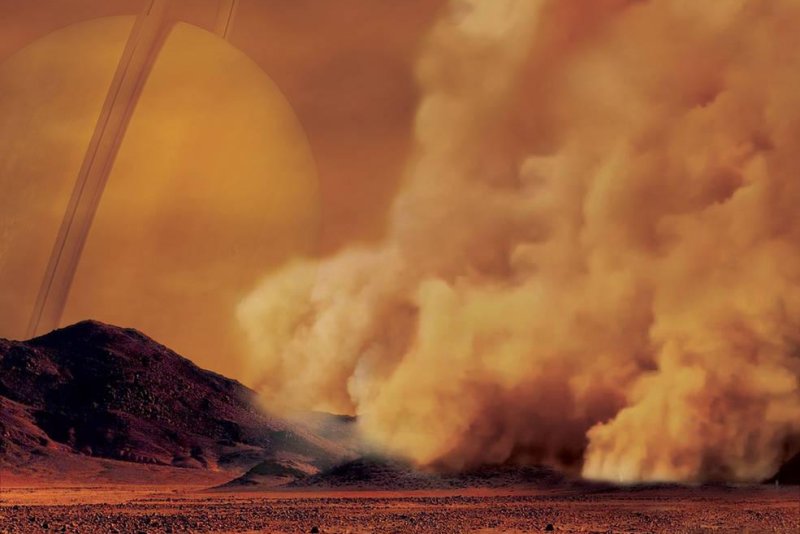An artist's rendering of a dust storm on Titan. Photo by IPGP/Labex UnivEarthS/University Paris Diderot -- C. Epitalon and S. Rodriguez
Sept. 25 (UPI) -- Titan, Saturn's largest moon, is home to dust storms. According to newly analyzed Cassini data, a large dust storm swirled across the moon's equator.
Scientists have previously documented geologic activity on Titan, as well as detailed the moon's dynamic hydrocarbon cycle. The latest observations -- detailed this week in the journal Nature Geoscience -- suggest Titan is also home to a dust cycle.
"Titan is a very active moon," Sebastien Rodriguez, an astronomer at Paris Diderot University, said in a news release.
Like Earth, Titan boasts a substantial atmosphere. The moon's surface is also home to sizable liquid bodies. But Titan's rivers and lakes are filled with liquid ethane, not water.
The moon's hydrocarbon fuels discernible weather patterns. The liquid hydrocarbon evaporates, forms clouds and returns as precipitation. Scientists have previously documented powerful methane storms near Titan's equator.
During several Titan flybys, Cassini observed what scientists believed to be another methane storm system. But a closer examination of the data revealed a different explanation.
"From what we know about cloud formation on Titan, we can say that such methane clouds in this area and in this time of the year are not physically possible," said Rodriguez. "The convective methane clouds that can develop in this area and during this period of time would contain huge droplets and must be at a very high altitude -- much higher than the 6 miles that modeling tells us the new features are located."
Chemical analysis confirmed the observed particles were atmospheric, hovering just above Titan's surface. Because the clouds were observed above the moon's dune fields, scientists hypothesized the cloud system comprised a dust storm.
Organic dust particles form from interactions between methane and sunlight. The dust is deposited in dunes near the equator, which are shaped by Titan's weather patterns. The latest findings suggest the moon hosts winds strong enough to propel large amounts of dust into the atmosphere.
"Such strong winds are expected to occur in downbursts during rare equinoctial methane storms," scientists wrote in their paper. "Our findings imply that Titan -- like Earth and Mars -- has an active dust cycle, which suggests that Titan's dune fields are actively evolving by aeolian processes."
It's not the first time scientists have observed dust activity on Titan.
"We believe that the Huygens Probe, which landed on the surface of Titan in January 2005, raised a small amount of organic dust upon arrival due to its powerful aerodynamic wake," said Rodriguez. "But what we spotted here with Cassini is at a much larger scale."
Earlier this year, scientists observed a large dust storm on Mars. Dust storms provide scientists a unique opportunity to understand the different atmospheric dynamics on planetary bodies.















